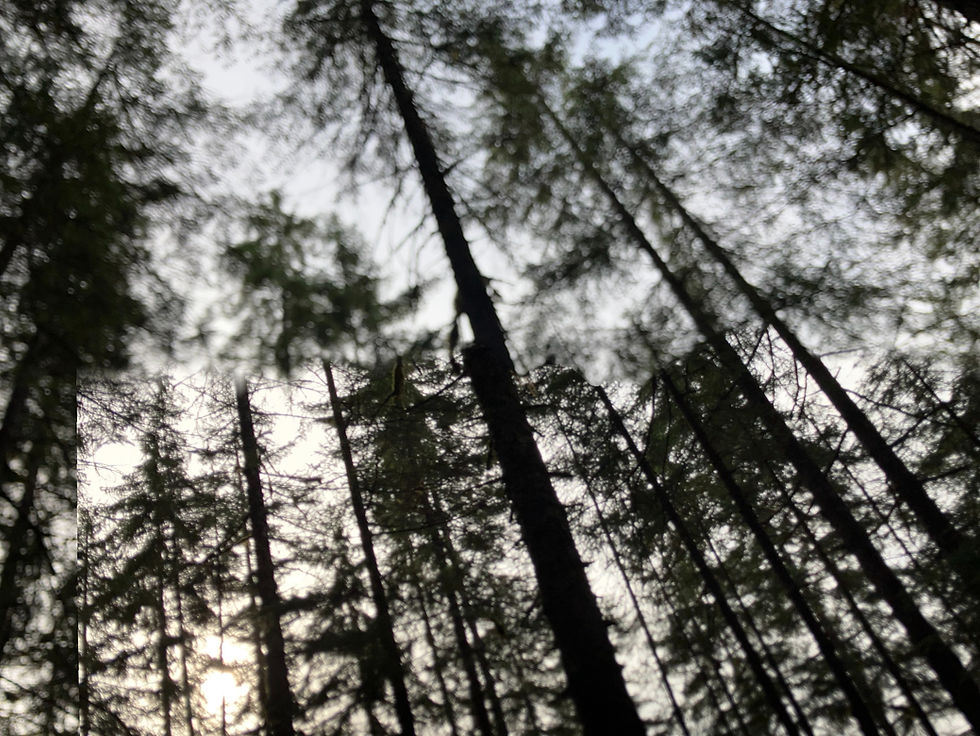On the Water
- stellahdawson
- Jun 3, 2024
- 4 min read
Updated: Jun 4, 2024

I never know my assignment from day to day. Our schedules are posted the evening before, after the cruise ships docking the next day have provided Gastinuea Guiding with their arrival times and how many passengers have signed up for our trips. I might start at 7 am, or it might be 2 pm.
So my day begins with a scramble: prepping food (no eating on tour), packing waterproofs (rain can start at anytime), grabbing educational materials (I’m in constant fear of running out of things to say), layering clothing (chilly at the glacier, colder out on the water) and donning my uniform (Gastineau Guiding hat, black top with logo, and a name tag). Thirty minute drive into downtown Juneau. Eiger often comes. He prefers the car to staying home alone. I meet my bus driver. We load up ponchos and walking sticks, trail snacks and water, and head off to the dock to meet the guests.
Five multi-story monster ships cruise up the Gastineau Channel each day, disgorging 16-20,000 visitors. They double the population of this little capital city for those 12 to 16 hours. I weave my way through a maze of umbrellas and anoraks, accents and languages to find our dock representative who has herded a huddle of guests disembarking from ships named things like Quantum of the Seas or Ruby Princess.
“Welcome to Juneau! Glad you are enjoying our liquid sunshine. So where are you from?”
I begin to take the measure of the guests – first time here/ never seen whales before/ adequate footwear for a hike/ physical limitations/ what might be their interests? - then we head to the bus. Mostly, I have led our Whales and Trails tours – 2 1/4 hours on the water and 1 1/4 hours walking in the rainforest with views of the Mendenhall Glacier. With bus transfer, its makes for a five-hour trip. Five hours of talking, explaining and interpreting local history, marine ecology, glaciology, temperate rainforest, forest succession, fauna and flora. It’s a lot, and it can be exhausting, but the more I learn, the more I have to say and the better I get at gauging what interests different people.
On the water, every day is different. We always see some humpback whales, whether it’s immediately we pull out of Auke Bay or after a half-hour run northeast to their feeding grounds. The humpbacks are migrating back from breeding in Hawaii, so more arrive each day, and they are hungry. Most fun are the young calves with their mothers. They splash their 15-foot-long pectoral fins like gangly teenagers trying to figure out how to use their newly grown bodies. They roll on their backs and slap their tails on the water.

Humpback shows its flukes as it dives
Sometime they are playing with the Stellar sea lions, which clamber over their backs and dive and splash around the whales. Occasionally, the whales breach, heaving their 50-foot bodies out of the water entirely, throwing themselves into the air, twisting around and splashing back downward. Other times, they hunch their backs and swish their massive tail muscles, the largest in the animal kingdom, upward as they dive deep and show off the flukes of their tails. We squeal and point in excitement, even the guides and the boat captain who see these performances every day. Each time it’s a thrill, especially when the water is calm and the snow-capped Chilkat Mountains visible beyond.
Other times, the waters are quiet for long stretches – no breaching, no spouting. We sit and wait, watching the peaceful waters and when the clouds have lifted, wonder at the wall of snow-capped mountains that stretch onward for tens of miles over 5,000 feet tall alongside the deep fjord-like channel, the deepest in the world, all the way up to Skagway. Or I will point out the Mendenhall, Eagle and Herbert glaciers, long rivers of slow-moving snow and ice laced with rock-strewn moraines weaving down the mountainside from the Juneau icefield, 1,500 square miles of ice, the fifth largest in North America and the size of Rhode Island.

From North Douglas beach to Mendenhall Glacier
When the whale action is limited, the boat captain will steer us northward to a rocky stretch of coastline on an island or to a buoy where the sea lions hang out. While humpback whales are comparatively solitary, sea lions live, play and breed in rowdy, tussling, tumbling groups, always jockeying for their place on the rocks, pushing each other around, diving in and out of the water, and roaring. The males are in constant competition to establish their prowess over a harem of females. They puff up their chests and rear up all, 1,200 lbs of them, on their hind flippers to stand taller than a man. Few males live past their teens the competition for dominance is so intense. It makes for a spectacular display when there are 30 or so piled up on a ledge of rocks.

Stellar sea lions resting at a haul-out
Then we head back to the dock for a walk in the rainforest.





Wow! Love the stories of guiding in Juneau. The humback breaching--what a picture!